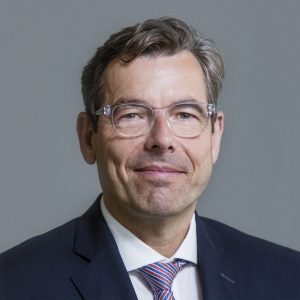Mr Dorgerloh, in late May 2020, the cupola above the portal towards Unter den Linden will be completed with the installation of the reconstructed lantern and a cross. What is so special about this event?
Hartmut Dorgerloh: On the one hand, the cupola, lantern and cross are the building elements of the reconstructed facade that are the most visible from far away. They are also masterpieces of artistry and craftsmanship. On the other, precisely those building elements sparked a major public debate about symbols. In order to explain this, I must elaborate somewhat: in May 2017, the Stiftung Humboldt Forum im Berliner Schloss thanked an individual for a generous donation that was to be used explicitly for the reconstruction of the cupola in a press release. This announcement led to a very passionate and controversial discussion that went on over several weeks and focused on the question of how the reconstruction of the cross in this location ought to be classified. Numerous people from the art and culture scene, the political and the science arenas, architecture and religious communities as well as also many civic society representatives voiced their respective opinions. To put it simply, the discussion raged between two opposite poles. Those on the one side view the cross as an exclusively Christian symbol that excludes people of the Jewish, Muslim or other faiths, which would run contrary to the Humboldt Forum’s function as a platform for international dialogue on global cultural issues. Others countered that the cross was an expression of our own history and cultural origins which we cannot now close our minds to.
Did this discussion have an internal impact at the Humboldt Forum? What are the current positions of the stakeholders with regard to this issue?
Of course we also continued the public debate internally, openly and transparently. Around a year ago, the department dedicated to the site history conducted an anonymous survey amongst the staff of all stakeholders – 171 colleagues from the Cultural Heritage Foundation (Stiftung Preußischer Kulturbesitz), which includes the Staatliche Museen zu Berlin (National Museums in Berlin), the Ethnologisches Museum (Ethnological Museum) and the Museum für asiatische Kunst (Asian Art Museum), Kulturprojekte Berlin and the Berlin City Museum Foundation (Stiftung Stadtmuseum Berlin) as well as the Humboldt-Universität zu Berlin and Stiftung Humboldt Forum im Berliner Schloss took part. What do you, personally, think of the reconstruction? What impact does the architecture have on our work in general? And, in particular, what is your opinion of the installation of the cross on the cupola? The feedback resulted in a critical, differentiated spectrum of opinions – ranging from enthusiasm about the reconstruction to “fight the building”. A large majority of the staff realise that the reconstruction of the facade with the regalia of the Prussian monarchy along with Christian inscriptions and symbols influences the contents of our work and our programme.
Were you able to formulate a shared perspective from this multi-layered spectrum of opinions?
Although this hardly seems impossible at first glance, due to the widely differing viewpoints, the four stakeholders developed a common public position precisely on the basis of this survey and the wide range of different opinions. We are reminding people of the cross-party resolution of the German Bundestag in 2002, where the consensus was that the facades should be reconstructed to look like the historic original, and of the fact that the architectural competition in 2008 therefore included a cupola. Such a historically accurate reconstruction therefore also has to include the inscriptions above the portals and on the cupola as well as all of the iconography, eagles, coats of arms, crowns – the lot. At the same time, we are emphasising that the Humboldt Forum is a venue for open, worldwide culture and science exchange – a place for diversity and discussion, but equally a place with a very unusual history. We must also view the complex and not unambiguous reconstruction of the building in this context – a reconstruction that is now based exclusively on urban planning and architectural culture aspects, and which was never about suggesting the reinstitution of the monarchy or dominance and the Christian claim to sole representation. We see all of these symbols as references to the building’s history, and do not associate any particular statement regarding the contents or, even worse, the programme for our joint work at the Humboldt Forum with them. They must be interpreted in the context of the respective historical situation at the time of their creation.
How will you deal with these in part problematic references in future?
These building elements, including their ambiguity and the circumstances surrounding their creation, are basically part of the Humboldt Forum’s DNA. What is important is transparency, contextualisation and communication. We as the developers and those who will jointly use the building are currently considering suitable tools and approaches to classifying the statements of the cupola and the facade that were recreated for historical reasons with publications, digital formats and special offers that address the history of the site. In addition, we will utilise the ambiguity of the architecture in order to not only encourage discussions about the multi-layered character of our world but to also facilitate temporary artistic interventions and explorations of the symbols on the Humboldt Forum. This ambiguity will never come to an end, neither now nor after the opening of the Humboldt Forum. We intend to consciously permit the diversity of the respective positions, classify them and then sometimes also grin and bear them. That is our mission and our concept – not only with regard to the issue of cupola and cross.
Mr Dorgerloh was interviewed by Ralf Hanselle.
